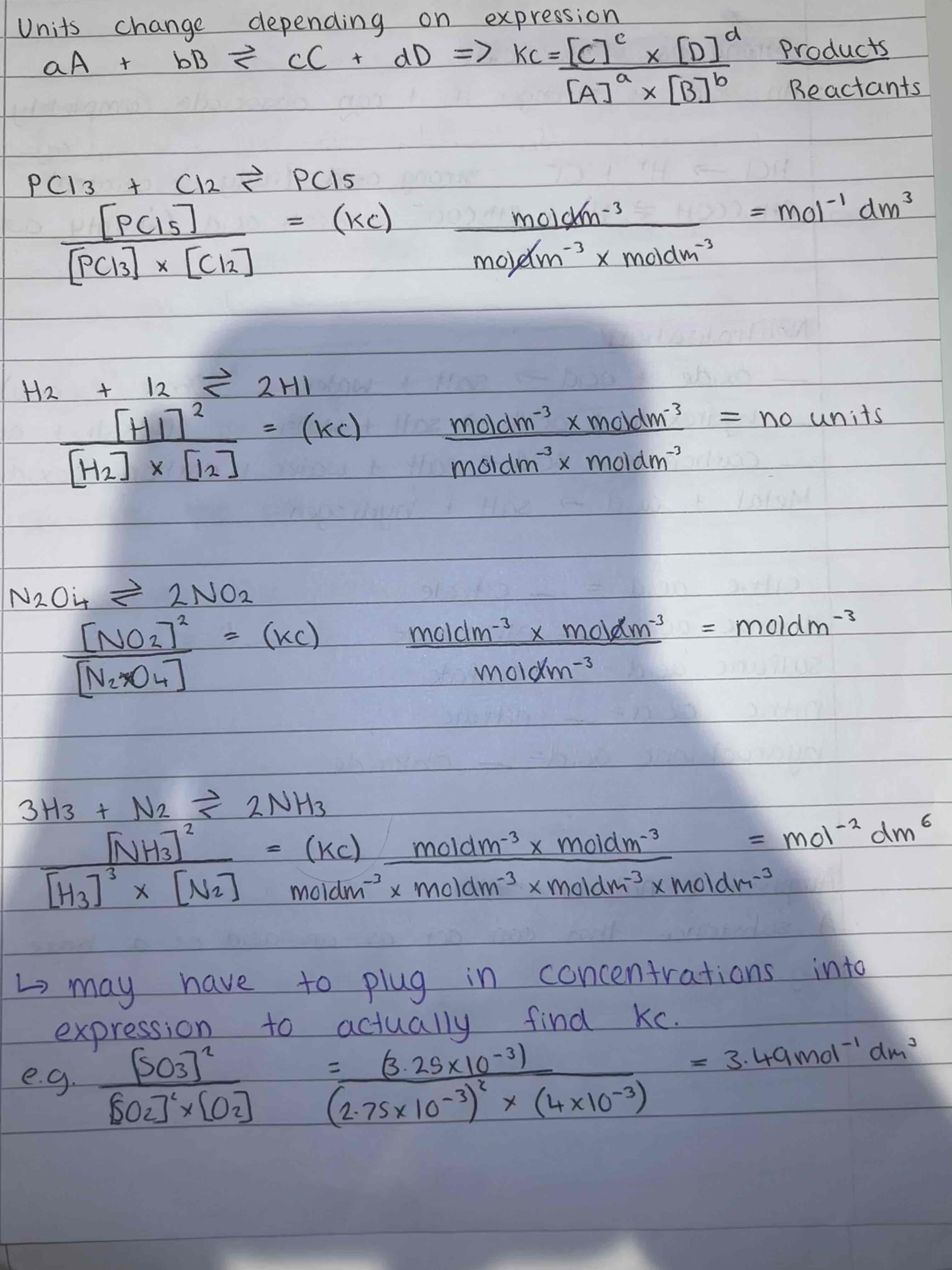1.7 Simple Equilibria and Acid-Base Reactions
1/29
Earn XP
Name | Mastery | Learn | Test | Matching | Spaced |
|---|
No study sessions yet.
30 Terms
What is dynamic equilibrium?
when the rate of forward reaction equals the rate of reverse reaction
What is homogenous equilibrium?
all products and reactants are in the same state
What is a heterogenous equilibrium?
not all products and reactants are in the same state
What is Le Chatelier’s principle?
if a change is introduced into a system in equilibrium, the system responds by opposing the change
Factors affecting equilibrium
concentration
temperature
pressure
catalyst
Cu2+ + 4Cl- ⇌ CuCl42-
blue + . ⇌ green
What is observed if the concentration of Cl- is increased?
Cl- has been added so the system wants to decrease the amount of Cl-
The rate of forward reaction increases
Equilibrium shifts in favour of products
A green colour is observed
2SO2 + O2 ⇌ 2SO3
→ -ΔH exothermic
← +ΔH endothermic
What happens to amount of SO3 if temperature is increased?
Temperature has been increased so the system wants to decrease the temperature
The rate of reverse endothermic reaction increases
Equilibrium shifts in favour of reactants
Amount of SO3 decreases
N2 + 3H2 ⇌ 2NH3
4 moles ⇌ 2 moles
What happens to amount of ammonia if pressure is increased?
Pressure has been increased so the system wants to decrease the pressure
The rate of forward reaction increases
Equilibrium shifts in favour of products
Amount of ammonia increases
Effect of catalysts
no effect on position of equilibria
only reduces time of reaction
Equilibrium constant formula
aA + bB ⇌ cC + dD = Kc = [C]c x [D]d
. [A]a x [B]b
How to work out Kc units

What is an acid?
proton (H+) donor
What is a base?
proton (H+) acceptor
base vs alkali
base = insoluble, alkali = soluble base
strong vs weak acid
an acid is stronger if it can dissociate completely
_ oxide + acid → (acid+base)
salt + water
_ hydroxide + acid → (acid+alkali)
salt + water
_ carbonate + acid →
salt + water + carbon dioxide
metal + acid →
salt + hydrogen
What is an amphoteric nature?
a substance that can act as an acid or a base e.g. water
What happens to pH if concentration increases?
pH decreases
pH =
-log [H+]
[H+] =
10-pH
Haber process
makes ammonia (alkali)
N2 + 3H2 ⇌ 2NH3
exothermic, ΔH = -92 kjmol-1
Haber process compromised conditions
200 atm (expensive+dangerous if higher)
450°C (reaction too slow if lower)
Fe catalyst
Contact process
makes sulfuric acid
2SO2 + O2 ⇌ 2SO3
exothermic, ΔH = -196 kjmol-1
Contact process compromised conditions
1-2 atm (expensive+dangerous if higher)
400°C-450°C (reaction too slow if lower)
V2O5 catalyst
pH of seawater
slightly alkaline
How is pH of seawater maintained?
maintained by buffering action of dissolved carbon dioxide, hydrogencarbonate, and carbonate ion
resists change in pH
Increasing CO2 affect on seawater
increasing concentration = decrease in pH
fears that increased acidity will be detrimental to marine life e.g. corals